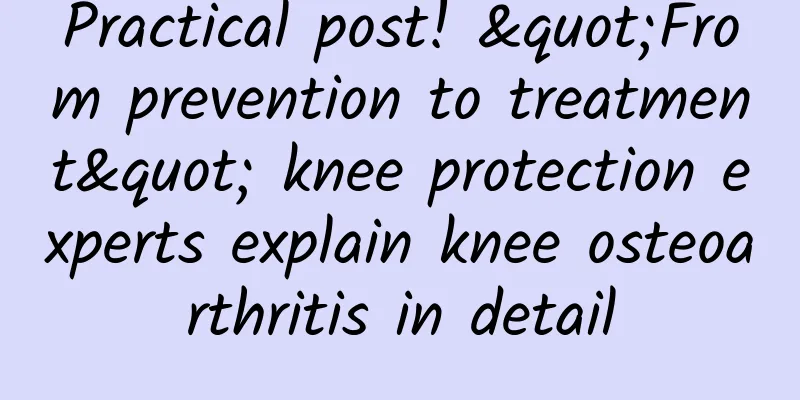Some people are alive, but their butts are already "dead"...

|
Work, work, I sit when I go to work, sit all day, and feel collapsed when I get home. Is this your normal state as a worker? If so, then be careful with your butt! You may have quietly developed " dead butt syndrome "! What is dead butt syndrome? When you first see this concept, are you curious about what dead butt syndrome is? Can the butt die? The term "Dead Butt Syndrome" was first proposed by Chris Kolba, a psychotherapist at the Veracruz Medical Center in Ohio, USA. It is also medically known as "Gluteal Amnesia". In simple terms, the buttocks muscles forget their job because they have not been working for a long time . Huh? You even forgot your job? Why is that? Because you always "bully" it! The most important risk factor for dead butt syndrome is sitting for long periods of time . Sitting still for a long time all day long causes the gluteal muscles to be compressed, relaxed and weak . Over time, the brain adapts to this abnormal state, and the emission of nerve signals gradually weakens. When we need the gluteal muscles to work again, they seem to have forgotten their function and cannot perform their due contraction function , causing a series of symptoms such as pain in the waist, hip and knee joints . Why does "dead butt syndrome" also cause back pain? This starts with the muscles in the buttocks. The function of the gluteus medius and gluteus minimus is to abduct the iliac joint. The anterior muscle bundle can internally rotate the thigh, while the posterior muscle bundle can externally rotate the thigh. Copyright images in the gallery. Reprinting and using them may lead to copyright disputes. When we exercise, the whole body is linked together and each muscle has its own function. If any muscle is lazy, the other muscles will share its work. When the gluteal muscles weaken, the waist and knee muscles will compensate. In addition to completing their own work, they also have to share the work of the gluteal muscles. Over time, this will cause strain on these compensatory muscles . This is why people who sit for long periods of time are more likely to suffer from back pain and leg cramps. How to tell if your butt is "dead" Look at the appearance The perky butt is gone, the butt is soft and flabby, and the appearance is not good. Pain in waist, hip, and knee joints After sitting for a long time, do you feel numbness, swelling, and soreness in your buttocks? Do you have frequent soreness and discomfort in your hip joints (hips), waist, and knee joints? If so, you should pay attention. Motion Detection In front of a mirror, raise your hands above your head and do squats . If you are unable to keep your upper body upright and are leaning forward with your knees coming together, commonly known as "knee-knocking," you may have dead butt syndrome. The picture comes from the Internet Another testing exercise is the single-leg hip bridge . Bend one leg and step firmly on the ground, straighten the other leg off the ground, use force to lift the hips until the bent knee thigh forms a 0° angle with the body, and support the ground with the upper back when the hips are lifted. It's up to you to decide whether it's your glutes that are working hard or other muscles that are compensating. If other muscles (lower back, knees) feel tired instead of your glutes , you may also have dead butt syndrome. Single-leg hip bridge, picture from the Internet How to Save a "Dead" Butt If dead butt syndrome occurs, you need to exercise the muscles in your buttocks (gluteus maximus, medius, and minimus) in time. The main ways of exercise include: Hip Bridge Copyright images in the gallery. Reprinting and using them may lead to copyright disputes. Lie on your back with your knees bent, feet on the ground, abdomen tightened, buttocks squeezed and lifted, so that the shoulders, hips, and knees are in the same straight line, and the thighs and calves are at 90 degrees when viewed from the side. Squat Copyright images in the gallery. Reprinting and using them may lead to copyright disputes. Place your feet shoulder-width apart and slightly abducted (no more than 30°), fully extend your hip and knee joints, and keep your body in a neutral position. When squatting, bend and abduct your knees, and move your buttocks backward and downward until the upper surface of your thighs is parallel to the ground. Clam-style opening and closing The picture comes from the Internet Lie on your side with your back straight, upper body relaxed, knees bent 90 degrees, and hips and legs in a straight line. Lift the knee of the upper leg upwards, feeling the gluteus medius and minimus muscles contract significantly, and it is best to lift it to an angle of about 75°. Keep your pelvis stable throughout the movement. Lower it down in a controlled rhythm until it is a little distance away from your knees, but not completely touching them. Deadlift The picture comes from the Internet Stand with your feet hip-width apart and toes slightly turned outward, at a suitable distance from the barbell, and hold the barbell with your hands on the outside of your calves. After holding the barbell, tighten your core, keep your spine in a neutral position, do not arch or bulge your back, and pull the barbell toward your body, making sure to keep your body tight throughout the process. When the barbell leaves the ground, keep your feet firmly on the ground, lift your chest up and pull your hips forward, fully extend your knees and hips, expand your shoulders to maintain stability, and then put the barbell back to the ground. Lunge Copyright images in the gallery. Reprinting and using them may lead to copyright disputes. Keep your body upright, tighten your core, and take a step forward about 2 shoulder widths. Squat down slowly, keeping your center of gravity between your feet. The knee of your front foot should not exceed your toes. The knee and toes should be in the same direction and facing outward. Be careful not to buckle your knee inward, and the knee of your back leg should not touch the ground. When the front thigh is parallel to the ground, pause for a moment, then return to the original standing position and repeat the movement with the other leg. Plank Copyright images in the gallery. Reprinting and using them may lead to copyright disputes. Put your feet together, with your toes touching the ground and your feet upright. The head, shoulders, back, hips and legs are on the same plane. The elbows are as wide as the shoulders, the elbows touch the shoulders on a vertical line, and the shoulders should not move forward beyond the elbows. We need to remind everyone not to exercise blindly, and try to exercise the gluteal muscles scientifically and formally under the guidance of a professional rehabilitation therapist or therapist . What I want to emphasize is that a great doctor treats illness before it occurs, and prevention is far more important than treatment. In 2020, the World Health Organization released the "Guidelines on Physical Activity and Sedentary Behavior". For adults, it is recommended to limit the time spent sitting and moving less. Any physical activity is beneficial. Therefore, it is recommended that you: 1. Stand up and move around for 10 minutes every hour to continuously send signals to the brain, activate the hip muscles, and stay active; 2. At least 150 to 300 minutes of moderate-intensity aerobic exercise or 75 to 150 minutes of higher-intensity aerobic exercise per week to improve muscle strength; 3. Maintain a healthy weight and avoid putting too much pressure on your hips. In short, avoid sitting for long periods of time, keep exercising, get your disappeared butt back, and enjoy a beautiful life! References [1] Anthony D Okely, AnnaKontsevaya, Johan Ng, Chalchisa Abdeta. 2020 WHO guidelines on physical activity and sedentary behavior. Sports Med Health Sci. 2021 May14;3(2):115-118. Author: Ji Gang, deputy chief physician of orthopedics, First Hospital of Hebei Medical University Reviewer: Tang Qin, Director and Researcher of the Science Popularization Department of the Chinese Medical Association |
>>: Inflate, deflate, inflate, deflate, inflate...can't deflate anymore!
Recommend
Can this much-hyped supplement really make your hair darker?
gossip “Taking tyrosine supplements can really ma...
What is the secret behind TikTok’s explosive user growth?
Think first: How do you measure user growth ? Wha...
Why are Capybaras so keen on rolling in the mud in the hot summer?
Yeah? Which two little guys are standing on the r...
Don’t know how to plan advertising? Here is a complete set of templates!
Information flow advertising is now the new favor...
For the sake of dead elephants, this place will no longer produce single-use plastic
The Sri Lankan government recently announced that...
After studying Mi Meng's 100+ articles, I discovered these secrets...
Mimi Meng - a super V in the field of new media w...
APIs you must know in Html5
The following is a summary of some HTML APIs that...
Pacific Rim Academy-MET Muscle Energy Technology
Pacific Rim Academy-MET Muscle Energy Technology ...
A review of 15 best-selling marketing campaigns in the first half of 2018
Looking back at the first half of 2018, marketing...
Pre-prepared meals are becoming more and more popular. Is it unhealthy to eat them frequently?
Have you heard of pre-prepared meals? There is a ...
Merchants have created mini programs, so how can they promote their mini programs for free?
One day, a "Jump Jump" applet appeared ...
What are the methods and techniques for online promotion?
Internet promotion is to publicize and promote pr...
Did Wang Feng make Xiaomi cry at the Meizu press conference on September 23?
On September 23, when you see Wang Feng singing o...
New research from Peking University! Intestinal fungi are the "trigger" of polycystic ovary syndrome
In the field of women's health, polycystic ov...
[Smart Farmers] How do fish swim from the ocean to the table? Baby fish fry also live in a big house!
Have you ever wondered how delicious seafood appe...









